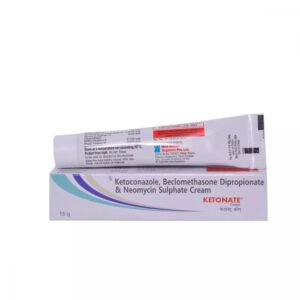BECLOMETHASONE + KETOCONAZOLE + NEOMYCIN
Beclomethasone: Beclomethasone is a corticosteroid medication used to treat various respiratory conditions such as asthma, allergic rhinitis (hay fever), and nasal polyps. It is available in different formulations, including inhalers for asthma and nasal sprays for allergic rhinitis.
The main mechanism of action of beclomethasone is its ability to reduce inflammation in the airways and nasal passages. It works by decreasing the production of inflammatory substances and suppressing the immune response in the affected areas. This helps to alleviate symptoms such as wheezing, shortness of breath, runny nose, sneezing, and nasal congestion.
For asthma, beclomethasone is typically used as a preventive medication to reduce the frequency and severity of asthma attacks. It is not suitable for relieving acute asthma symptoms. Patients are advised to use it regularly, even when they are feeling well, to maintain control over their asthma.
The dose of beclomethasone can vary depending on the specific formulation, severity of the condition, and the individual’s response to the medication. The dosing instructions should be carefully followed as prescribed by the healthcare provider. For inhalers, it is typically recommended to use 1-2 inhalations, twice daily. For nasal sprays, the usual dose is 1-2 sprays into each nostril, once or twice daily.
Like any medication, beclomethasone can have side effects. The most common side effects include nasal irritation, dryness, or a mild nosebleed with the nasal spray formulation. With the inhaler formulation, it is possible to experience a sore throat, cough, or thrush (a fungal infection) in the mouth or throat. These side effects are generally mild and can be minimized by using the correct technique, rinsing the mouth after inhalation, and using a spacer device with the inhaler.
Systemic side effects (those affecting the whole body) are rare but may occur, especially with long-term use or high doses. These can include adrenal suppression, increased susceptibility to infections, osteoporosis, skin thinning or bruising, and slowed growth in children. It is important to use beclomethasone as prescribed and regularly check in with a healthcare provider to monitor for any potential side effects.
It is worth noting that this is a general overview of beclomethasone. Always consult with a healthcare professional for personalized information and advice regarding the appropriate use, dose, and potential side effects of any medication.
Ketoconazole: Ketoconazole is an antifungal medication used to treat various fungal infections. It works by blocking the synthesis of ergosterol, a vital component of the fungal cell membrane, causing the membrane to become weak and leaky. This ultimately leads to the death of the fungus.
Ketoconazole can be used to treat infections such as athlete’s foot (tinea pedis), ringworm (tinea corporis), jock itch (tinea cruris), and yeast infections (candidiasis). It can also be prescribed for more severe infections such as fungal meningitis and systemic candidiasis.
The dosage of ketoconazole may vary depending on the type and severity of the infection. For superficial infections, topical creams or shampoos containing 2% ketoconazole are often used. These are typically applied to the affected area once or twice daily until the infection clears. For systemic infections, oral ketoconazole tablets are prescribed at a dose of 200-400 mg per day. The treatment duration can range from a few days to several weeks, depending on the condition being treated.
Like any medication, ketoconazole can have side effects. Common side effects include nausea, vomiting, abdominal pain, and diarrhea. It may also cause skin reactions such as itching, rash, or hives. In rare cases, more severe side effects can occur, such as liver damage or allergic reactions. Ketoconazole can interact with certain medications, so it is important to inform your healthcare provider about any other medications you are taking before starting ketoconazole.
Due to the potential for liver toxicity, the use of oral ketoconazole has been restricted in some countries. It is important to follow the prescribed dosage and duration of treatment and to discuss any concerns or side effects with a healthcare professional.
Neomycin: Neomycin is an antibiotic drug that is primarily used to treat bacterial infections of the skin and intestines. It belongs to the aminoglycoside class of antibiotics and is particularly effective against gram-negative bacteria.
Neomycin works by inhibiting protein synthesis in bacteria, leading to their death or growth inhibition. It achieves this by binding to the bacterial ribosome, thereby preventing the production of essential proteins necessary for bacterial survival.
This medication is most commonly available as topical preparations for skin infections and as an oral form for intestinal infections. Neomycin is not typically used systemically due to its poor absorption from the gastrointestinal tract.
When used topically, neomycin is usually applied to the affected area 2-3 times daily. For intestinal infections, the oral dose may vary, but a typical regimen is 500 mg every 6 hours for adults and 25-35 mg/kg/day in divided doses for children.
Although generally considered safe and effective, neomycin can have potential side effects. Common side effects include skin irritation, itching, and redness at the site of application for topical forms. When taken orally, neomycin can cause gastrointestinal symptoms such as nausea, vomiting, diarrhea, and stomach cramps. Prolonged use or high doses of neomycin can also increase the risk of developing superinfections or allergic reactions.
It is important to note that neomycin is not recommended for individuals with a known hypersensitivity to aminoglycosides, as they may experience severe allergic reactions. Additionally, neomycin should be used with caution in patients with pre-existing kidney disease, as the drug can further impair kidney function.
To ensure the safe and effective use of neomycin, it is advised to follow the prescribed dose and duration of treatment recommended by the healthcare provider.

